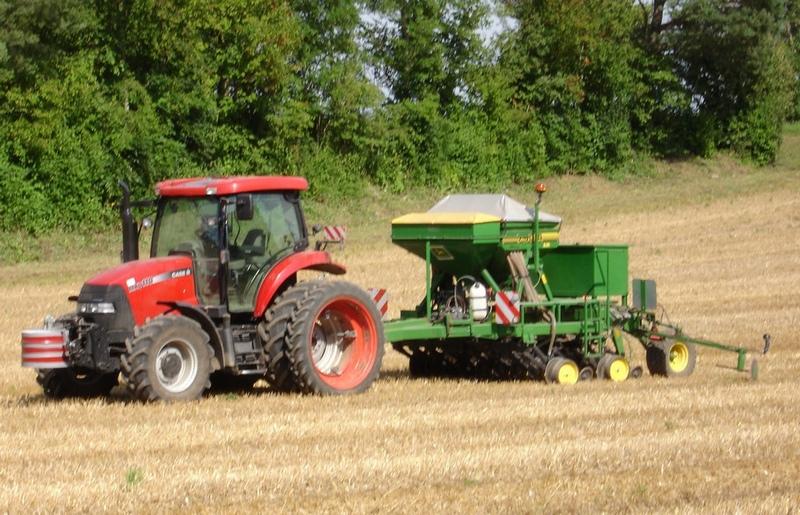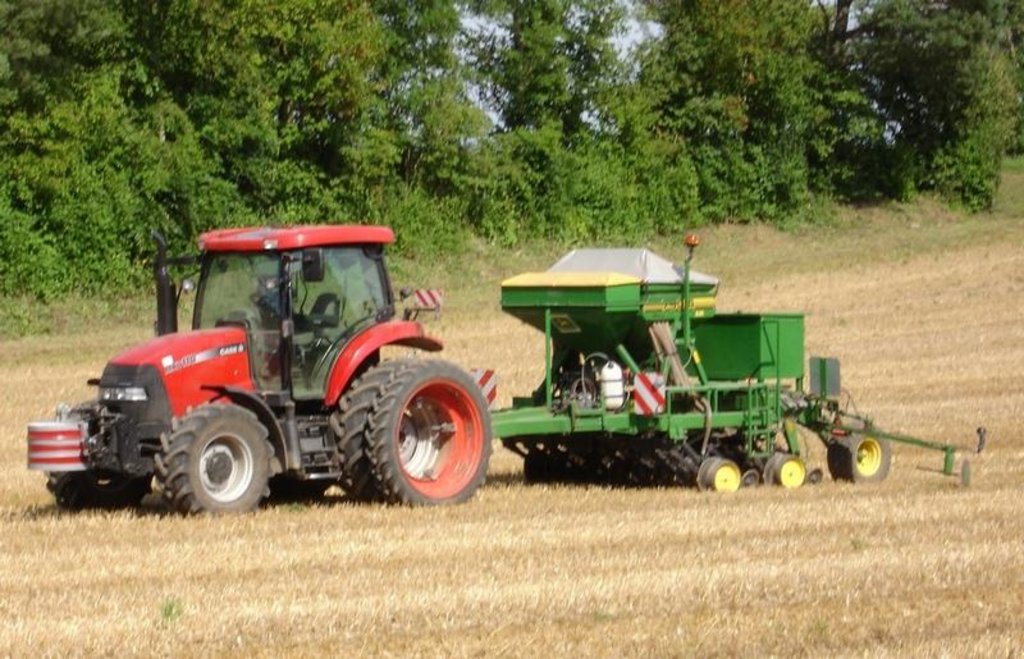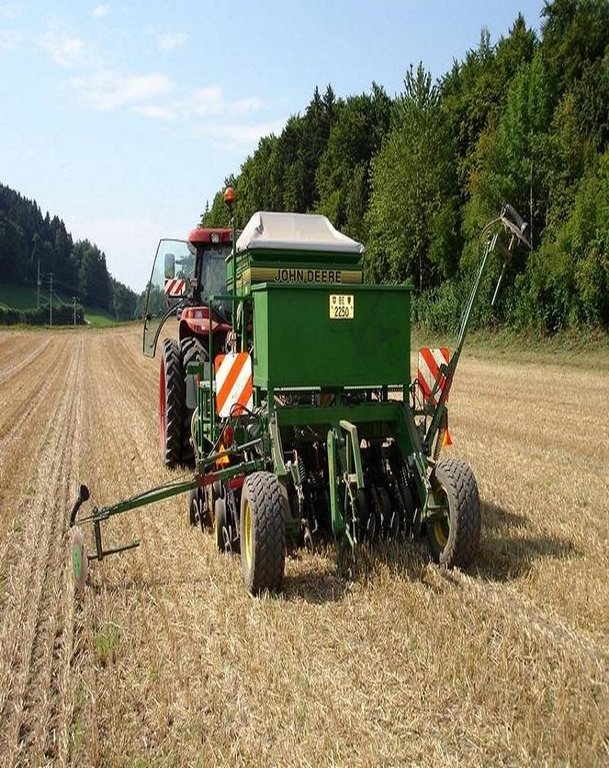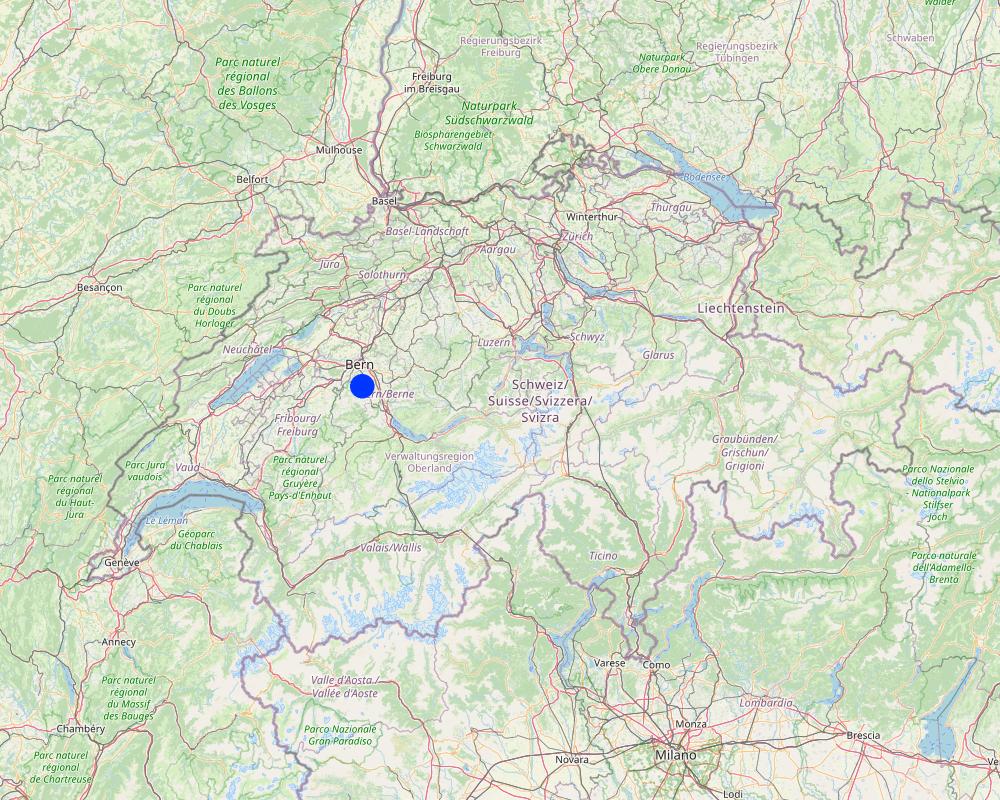Direct seeding [سويسرا]
- تاريخ الإنشاء:
- تحديث:
- جامع المعلومات: Unknown User
- المحرر: –
- المراجعون: Fabian Ottiger, Alexandra Gavilano, Joana Eichenberger
Direktsaat (German)
technologies_1007 - سويسرا
عرض الأقسام
توسيع الكل طي الكل1. معلومات عامة
1.2 تفاصيل الاتصال بالأشخاص الرئيسيين لمصدر المعلومات والمؤسسات المشاركة في تقييم وتوثيق التقنية
الشخص (الأشخاص) الرئيسي لمصدر المعلومات
متخصص في الإدارة المستدامة للأراضي:
Wyler Roman
Center for Development and Environment, University of Berne
سويسرا
مستخدم الأرض:
Streit Thomas
سويسرا
اسم المشروع الذي سهّل توثيق/تقييم التقنية (إذا كان ذلك على صلة)
OPtimal strategies to retAIN and re-use water and nutrients in small agricultural catchments across different soil-climatic regions in Europe (OPTAIN)اسم المؤسسة (المؤسسات) التي سهلت توثيق/تقييم التقنية (إذا كان ذلك على صلة)
CDE Centre for Development and Environment (CDE Centre for Development and Environment) - سويسرا1.3 الشروط المتعلقة باستخدام البيانات الموثقة من خلال WOCAT
يوافق جامع المعلومات والشخص (لاشخاص) الرئيسي لمصدر المعلومات على الشروط المتعلقة باستخدام البيانات الموثقة من خلال WOCAT:
نعم
1.5 الإشارة إلى الاستبيان (الاستبيانات) حول مناهج الإدارة المستدامة للأراضي (موثقة باستخدام WOCAT)
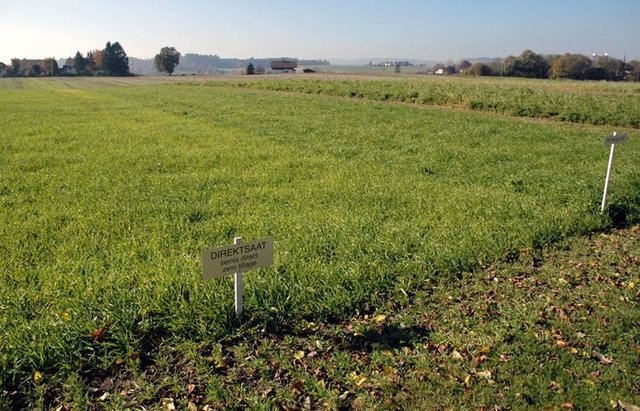
Subsidies for conservation agriculture [سويسرا]
Land users commit to apply conservation agriculture on parts of their land for a period of 5 years. In return they get subsidies during this period.
- جامع المعلومات: Unknown User
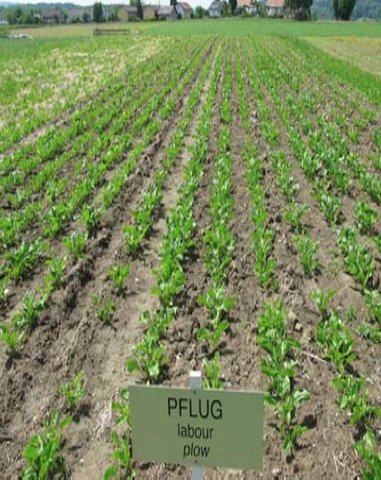
Soil support program for conservation agriculture [سويسرا]
Through the soil support program land users get subsidies for applying conservation technologies on their fields during a period of 6 years.
- جامع المعلومات: Deborah Niggli
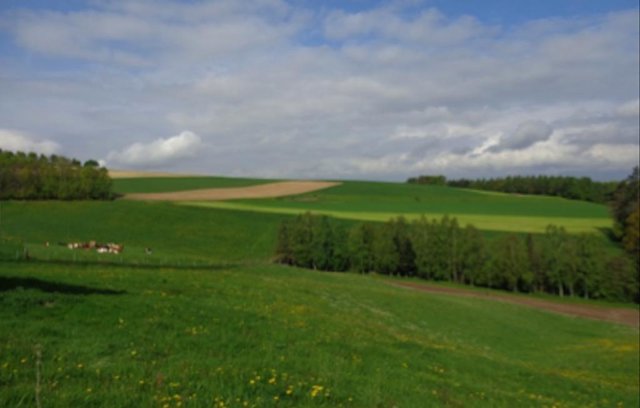
Direktzahlungssystem [سويسرا]
Finanzielle Leistungen des Bundes um den Ertragsverlust, den eine Kultur für den Bauern bringt, auszugleichen. Das Direktzahlungssystem führt gewissermassen zu einer 'Vergünstigung des Produkts' für den Konsumenten.
- جامع المعلومات: Deborah Niggli
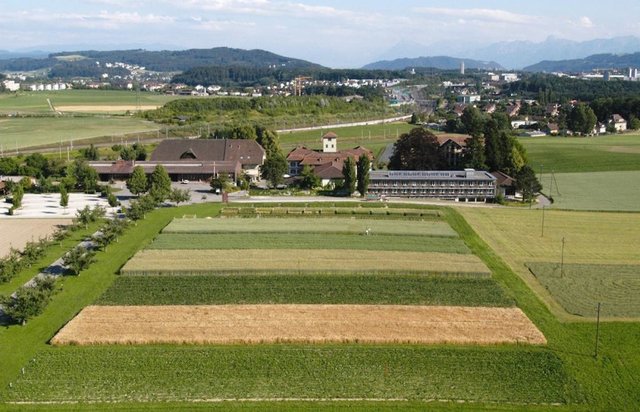
Förderprogramm Boden [سويسرا]
Mit dem Förderprogramm Boden des Kantons Bern erhalten beteiligte Landnutzer Direktzahlungen für die Anwendung von bodenkonservierenden Anbauverfahren auf ihren landwirtschaftlichen Feldern. Das Projekt hat eine Dauer von 6 Jahren.
- جامع المعلومات: Deborah Niggli
2. وصف تقنيةالإدارة المستدامي للأراضي
2.1 وصف مختصر للتقنية
تعريف التقنية:
A cropping system which allows to plant the seeds directly into the soil without ploughing. The soil is covered with plant remainders.
2.2 وصف تفصيلي للتقنية
الوصف:
The farm portaited is located in a hilly area near Bern. It is cooperating with an other farm of the village so that in total 32 ha of arable land are cultivated. All crops except for potatoes and sugar beets are produced within the no-tillage system. So the area cultivated with the no-tillage system is about 26 ha. The farm is producing mainly fodder (maize, wheat) for pigs. Beside this potatoes and sugar beets are produced to be sold. A typical crop rotation consists of a root crop, followed by a winter grain and a green manure. There are major meadows, too.
No-tillage characterizes a cultivation system without ploughing or any other reworking of the soil. After the previous crop (Maize, grain) has been harvested, a total herbicide is applied and the seeds are brought directly into the soil with a special machine. A metal disk carves a narrow slit into the surface. Then the seeds are brought into the soil pneumatically. Finally, the slit is closed again by two wheels pressing on the surface.
The no-tillage system is used to reduce soil degradation, especially erosion. It enables a permanent cover of the soil surface, which reduces sealing and crusting. Since they are not disturbed by ploughing anymore, there are more earthworms in the soil. Their activity can slowly reduce compaction and improve the soil structure. This leads to better infiltration rates and also to a higher water storage capacity. Less water remains on the soil surface, so soil loss can be reduced.
The no-tillage system requires a special direct seeding machine. This machine is very expensive, so most farmers don’t buy it on their own but task a contractor with the seeding. On the other hand, certain machines from conventional agriculture are not needed anymore (plough, harrow, rotary tiller etc.). Furthermore, working hours and fuel can be saved. In some cantons of switzerland no-tillage agriculture is also subsidised. For this reason, the method holds economic advantages, too.
In the beginning crop yield may be reduced by up to 10%. The rebuilding of the soil structure requires a certain time, depending on the state of the soil at the time of transition. However, this was not the case for the farm portaited here: Already in the first year there were very good crop yields, although the probability for crop loss is higher in the no-tillage system. Competition between the crops and weeds can be too strong if the total herbicide is applied under wet conditions. In addition drying of the soil in spring is often delayed. Thus the plants may face too wet conditions.
2.3 صور التقنية
2.5 البلد/المنطقة/المواقع التي تم تنفيذ التقنية فيها والتي يغطيها هذا التقييم
البلد:
سويسرا
المنطقة/الولاية/المحافظة:
Gemeinde Wald
مزيد من التفاصيل حول الموقع:
Kanton Bern
التعليقات:
The farm owns 0.27 km2. For reasons of rationalization it is working together with another farm. Together they have 0.32 km2. On 0.26 km2 direct seeding is applied.
Total area covered by the SLM Technology is 0.26 km2.
Map
×2.6 تاريخ التنفيذ
في حالة عدم معرفة السنة بالتحديد، يرجى الإشارة إلى التاريخ التقريبي:
- منذ 10-50 سنة
2.7 إدخال التقنية
حدد كيف تم إدخال التقنية:
- أثناء التجارب/الأبحاث
التعليقات (نوع المشروع، الخ):
modern direct seeding was developed since the 1950s after the development of modern herbicides.
3. تصنيف تقنية الإدارة المستدامي للأراضي
3.2 نوع (أنواع) استخدام الأراضي الحالية حيث يتم تطبيق التقنية

الأراضي الزراعية
- زراعة سنوية
الزراعة السنوية - حدد المحاصيل:
- محاصيل الأعلاف - الأعشاب
عدد مواسم الزراعة في السنة:
- 2
حدد:
Longest growing period in days: 230Longest growing period from month to month: Mar - OctSecond longest growing period in days: 300Second longest growing period from month to month: Nov - Aug
التعليقات:
Major land use problems (land users’ perception): Soil erosion, soil compaction at different dephts
Future (final) land use (after implementation of SLM Technology): Cropland: Ca: Annual cropping
3.4 إمدادات المياه
إمدادات المياه للأرض التي يتم تنفيذ التقنية عليها:
- بعلية
3.5 مجموعةالإدارة المستدامة للأراضي التي تنتمي إليها هذه التقنية
- الحد الأدنى من اختلال التربة
3.6 التدابير التقنية في مجال إلادارة المستدامة للأراضي
3.7 الأنواع الرئيسية من تدهور الأراضي التي تناولتها التقنية

تآكل التربة بالمياه
- الوزن(Wt): فقدان التربة السطحية/تآكل السطح

التدهور المادي أو الفيزيائي للتربة
- (Pc) : تراص التربة

التدهور البيولوجي
- (Bc): تناقص الغطاء النباتي
- (Bl): فقدان الحياة بالتربة
التعليقات:
Main type of degradation addressed: Wt: loss of topsoil / surface erosion, Bc: reduction of vegetation cover, Bl: loss of soil life
Secondary types of degradation addressed: Pc: compaction
Main causes of degradation: crop management (annual, perennial, tree/shrub) (unprotected soil surface in conventional agriculture), Heavy / extreme rainfall (intensity/amounts), education, access to knowledge and support services (Tradition. In general ploughing is not questioned.)
3.8 منع أو حد أو عكس تدهور الأراضي
تحديد هدف التقنية فيما يتعلق بتدهور الأراضي:
- منع تدهور الأراضي
- الحد من تدهور الأراضي
التعليقات:
Main goals: prevention of land degradation
Secondary goals: mitigation / reduction of land degradation
4. المواصفات الفنية، وأنشطة التنفيذ، والمدخلات، والتكاليف
4.1 الرسم الفني للتقنية
المواصفات الفنية (المتعلقة بالرسم الفني):
Technical knowledge required for field staff / advisors: high (the correct timing of activities is difficult to achieve. The current weather situation has a great influence.)
Technical knowledge required for land users: high (crop rotation needs to be adjusted)
Main technical functions: control of raindrop splash, improvement of ground cover, improvement of surface structure (crusting, sealing)
Secondary technical functions: improvement of topsoil structure (compaction), improvement of subsoil structure (hardpan), stabilisation of soil (eg by tree roots against land slides), increase in organic matter, increase of infiltration, increase / maintain water stored in soil
Better crop cover
Remarks: precedent crop remains on the soil
Retaining more vegetation cover
Remarks: precedent crop remains on the soilprecedent crop remains on the soil
Green manure
Remarks: no change compared to conventional agriculture
Manure / compost / residues
Material/ species: liquid pig manure
Remarks: no change compared to conventional agriculture
Mineral (inorganic) fertilizers
Remarks: no change compared to conventional agriculture
Rotations / fallows
Remarks: new crop rotation is needed
Zero tillage / no-till
Remarks: all crops except potatoes and sugar beets, where mulching is applied
4.2 معلومات عامة بخصوص حساب المدخلات والتكاليف
عملة أخرى/ عملة وطنية (حدد):
Swiss Franc
إذا كان ذا صلة، وضح سعر الصرف من الدولار الأمريكي إلى العملة المحلية (على سبيل المثال، 1 دولار أمريكي = 79.9 ريال برازيلي): 1 دولار أمريكي =:
1,08
4.3 أنشطة التأسيس
| النشاط | التوقيت (الموسم) | |
|---|---|---|
| 1. | Buy a direct seeding machine |
4.4 التكاليف والمدخلات اللازمة للتأسيس
| تحديد المدخلات | الوحدة | الكمية | التكاليف لكل وحدة | إجمالي التكاليف لكل مدخل | % من التكاليف التي يتحملها مستخدمو الأراضي | |
|---|---|---|---|---|---|---|
| معدات | Direct seeding machine | Machine | 1,0 | 278000,0 | 278000,0 | 100,0 |
| إجمالي تكاليف إنشاء التقنية | 278000,0 | |||||
| إجمالي تكاليف إنشاء التقنية بالدولار الأمريكي | 257407,41 | |||||
التعليقات:
Duration of establishment phase: 0 month(s)
4.5 الصيانة/الأنشطة المتكررة
| النشاط | التوقيت/الوتيرة | |
|---|---|---|
| 1. | Appliance of total herbicide (glyphosat) | 1 per growing period |
| 2. | Seeding | 1 per growing period |
| 3. | spreading of snail poison | 1-3 per growing period |
4.6 التكاليف والمدخلات اللازمة للصيانة/للأنشطة المتكررة (سنويًا)
| تحديد المدخلات | الوحدة | الكمية | التكاليف لكل وحدة | إجمالي التكاليف لكل مدخل | % من التكاليف التي يتحملها مستخدمو الأراضي | |
|---|---|---|---|---|---|---|
| العمالة | Seeding | ha | 1,0 | 185,0 | 185,0 | 100,0 |
| العمالة | Spreading of snail poison | ha | 1,0 | 46,0 | 46,0 | 100,0 |
| الأسمدة والمبيدات الحيوية | Biocides | ha | 1,0 | 56,0 | 56,0 | 100,0 |
| غير ذلك | Appliance of herbicide | ha | 1,0 | 93,0 | 93,0 | 100,0 |
| إجمالي تكاليف صيانة التقنية | 380,0 | |||||
| إجمالي تكاليف صيانة التقنية بالدولار الأمريكي | 351,85 | |||||
التعليقات:
New direct seeding machines usually cost $45'000. The farmer portraited bought a second hand machine for $27800. To calculate the costs it was assumed that all work is outsorced to a contracter (which is not usually the case). One growing period per year was assumed, in reality it 1-2. Worksteps which are the same in direct seeding and conventional agriculture were not included. The following worksteps are additional to conventional agriculture (working hours, costs): Appliance of total herbicide ((0.75h, $149), direct seeding (0.5h, $185), spreading of snail poison (0.5h, $83). The following steps are not needed anymore: ploughing (2.5h, $260), harrowing (1.25h, $185), conventional seeding (1h, $102). So in total about 3.75h and $130 can be saved per ha and growing period. Besides this, direct seeding is subsidised in the Canton Bern. The subsidies sum up to $250-$500 per ha and year for a period of 5 years. These subsidies are an important reason for the growing popularity of conservation agriculture in Switzerland. The most important income source for Swiss farmers are direct subsidies, which are about $1400 per ha and year. To get these subsidies, farmers have to fulfill ecological criteria.
4.7 أهم العوامل المؤثرة على التكاليف
قدم وصفا لأهم العوامل التي تؤثر على التكاليف:
The most important factor is whether a direct seeding machine can be rented in locally, because this represents a major investment.
5. البيئة الطبيعية والبشرية
5.1 المناخ
هطول الأمطار السنوي
- < 250 مم
- 251- 500 ملم
- 501 - 750ملم
- 1,000-751 ملم
- 1,500-1,100 ملم
- 2,000-1,500 ملم
- 3,000-2,001 ملم
- 4,000-3,100 ملم
- > 4000 ملم
المواصفات/التعليقات على هطول الأمطار:
precipitation during the whole year. The maximum lies in summer.
المنطقة المناخية الزراعية
- شبه رطبة
Thermal climate class: temperate
5.2 طوبوغرافيا
متوسط الانحدارات:
- مسطح (0-2%)
- بسيط (3-5%)
- معتدل (6-10%)
- متدحرج (11-15%)
- تلال (16-30%)
- شديدة الانحدار(31-60%)
- فائقة الانحدار (>60%)
التضاريس:
- هضاب/سهول
- أثلام مرتفعة
- المنحدرات الجبلية
- منحدرات التلال
- منحدرات في السفوح
- قاع الوادي
المنطقة الارتفاعية:
- 100-0 متر فوق سطح البحر
- 500-101 متر فوق سطح البحر
- 1,000-501 متر فوق سطح البحر
- 1,500-1,001 متر فوق سطح البحر
- 2,000-1,501 متر فوق سطح البحر
- 2,500-2,100 متر فوق سطح البحر
- 3,000-2,501 متر فوق سطح البحر
- 4,000-3,001 متر فوق سطح البحر
- > 4000 متر فوق سطح البحر
5.3 التربة
متوسط عمق التربة:
- ضحل جدًا (0-20 سم)
- ضحلة (21-50 سم)
- متوسطة العمق (51-80 سم)
- عميقة (81-120 سم)
- عميقة جدًا (> 120 سم)
قوام التربة (التربة السطحية):
- متوسط ( طميي، سلتي)
المواد العضوية في التربة السطحية:
- عالية (>3%)
- متوسطة (1-3%)
إذا كان متاحًا، قم بإرفاق وصف كامل للتربة أو تحديد المعلومات المتوفرة، على سبيل المثال نوع التربة، الرقم الهيدروجيني/ درجة حموضة التربة، قدرة التبادل الكاتيوني، النيتروجين، الملوحة وما إلى ذلك.
Soil texture is medium (loamy/silty and sandy)
Soil fertility is high
Soil drainage/infiltration is good
Soil water storage capacity is high
5.4 توافر المياه ونوعيتها
منسوب المياه الجوفية:
50-5 م
نوعية المياه (غير المعالجة):
مياه شرب جيدة
تعليقات ومواصفات أخرى بشأن نوعية المياه وكميتها:
Availability of surface water: good, medium
5.5 التنوع البيولوجي
تنوع الأنواع:
- متوسط
5.6 خصائص مستخدمي الأراضي الذين يطبقون التقنية
التوجه السوقي لنظام الإنتاج:
- تجاري/سوق
الدخل من خارج المزرعة:
- أقل من % 10من كامل الدخل
المستوى النسبي للثروة:
- متوسط
أفراداً أو مجموعات:
- فرد/أسرة معيشية
مستوى المكننة:
- ميكانيكية/ مزودة بمحرك
الجنس:
- رجال
اذكر الخصائص الأخرى ذات الصلة لمستخدمي الأراضي:
Land users applying the Technology are mainly common / average land users
Difference in the involvement of women and men: In Switzerland there are mostly men who apply the technology. However, the decision making usually takes place at the household level, including both men and women.
Population density: 50-100 persons/km2
Annual population growth: negative
Off-farm income specification: Many farmers in Switzerland have significant off farm income. But this seems to be independent of the technology applied.
5.7 متوسط مساحة الأرض التي يستخدمها مستخدمو الأراضي الذين يطبقون التقنية
- < 0.5 هكتارا
- 0.5 - 1 هكتار
- 1 -2 هكتار
- 2 - 5 هكتار
- 5 - 15 هكتار
- 15 - 50 هكتار
- 50 - 100هكتار
- 500-100 هكتار
- 1,000-500 هكتار
- 10,000-1,000 هكتار
- > 10,000 هكتار
هل يعتبر هذا نطاقًا صغيرًا أو متوسطًا أو واسعا (في إشارة إلى السياق المحلي)؟:
- على نطاق متوسط
5.8 ملكية الأراضي، وحقوق استخدام الأراضي، وحقوق استخدام المياه
ملكية الارض:
- فردية، يوجد سند ملكية
حقوق استخدام الأراضي:
- مؤجر
- فردي
حقوق استخدام المياه:
- مجتمعي (منظم)
التعليقات:
Population growth in Switzerland is about 0.6% per year. In the commune discussed here it's about -0.6%.
5.9 الوصول إلى الخدمات والبنية التحتية
الصحة:
- ضعيف
- معتدل
- جيد
التعليم:
- ضعيف
- معتدل
- جيد
المساعدة التقنية:
- ضعيف
- معتدل
- جيد
العمل (على سبيل المثال خارج المزرعة):
- ضعيف
- معتدل
- جيد
الأسواق:
- ضعيف
- معتدل
- جيد
الطاقة:
- ضعيف
- معتدل
- جيد
الطرق والنقل:
- ضعيف
- معتدل
- جيد
مياه الشرب وخدمات الصرف الصحي:
- ضعيف
- معتدل
- جيد
الخدمات المالية:
- ضعيف
- معتدل
- جيد
6. الآثار والتصريحات الختامية
6.1 الآثار التي أظهرتها التقنية في الموقع
الآثار الاجتماعية والاقتصادية
الإنتاج
إنتاج المحاصيل
التعليقات/ حدد:
not in general, but can occur in the beginning
إنتاج الأعلاف
خطر فشل الإنتاج
التعليقات/ حدد:
reduced risk for production failure due to erosion but the technology is sensitive to wet conditions in spring. Risk of crop failure due to snails is enhanced
توافر المياه ونوعيتها
الطلب على مياه الري
التعليقات/ حدد:
irrelevant in the area
الدخل والتكاليف
النفقات على المدخلات الزراعية
التعليقات/ حدد:
no reworking of the soil but major initial investment if no direct seeding machine is available for rent.
دخل المزرعة
التعليقات/ حدد:
due to reduced expenses
عبء العمل
التعليقات/ حدد:
no reworking of the soil
الآثار الاجتماعية والثقافية
الفرص الثقافية
التعليقات/ حدد:
ploughing is a major part of rural identity. Farmer become more dependent on others if work is outsourced to contractors.
الآثار الايكولوجية
دورة المياه / الجريان السطحي
الجريان السطحي
التربة
رطوبة التربة
غطاء التربة
فقدان التربة
تكون قشرة التربة السطحية/انسداد مسام التربة
تراص التربة
المادة العضوية في التربة/تحت الطبقة c
التنوع البيولوجي: الغطاء النباتي، الحيوانات
الأنواع المفيدة
الآثار الايكولوجية الأخرى
Hazard towards adverse events
التعليقات/ حدد:
better soil cover leads to higher tolerance against intense rain. Increased soil moisture leads to higher tolerance against droughts
6.2 الآثار التي أظهرتها التقنية خارج الموقع
الأضرار التي لحقت بحقول الجيران
التعليقات/ حدد:
erosion is almost negligible
الضرر على البنية التحتية العامة/ الخاصة
6.3 تعرض التقنية وحساسيتها لتغير المناخ التدريجي والظواهر المتطرفة/الكوارث المرتبطة بالمناخ (كما يراها مستخدمو الأراضي)
تغير مناخ تدريجي
تغير مناخ تدريجي
| الموسم | زيادة أو نقصان | كيف تتعامل التقنية مع ذلك؟ | |
|---|---|---|---|
| درجة الحرارة السنوية | زيادة | غير معروف |
الظواهر المتطرفة / الكوارث المرتبطة بالمناخ
الكوارث الجوية
| كيف تتعامل التقنية مع ذلك؟ | |
|---|---|
| عاصفة ممطرة محلية | جيدا |
| عاصفة هوائية محلية | غير معروف |
الكوارث المناخية
| كيف تتعامل التقنية مع ذلك؟ | |
|---|---|
| جفاف | جيدا |
الكوارث الهيدرولوجية
| كيف تتعامل التقنية مع ذلك؟ | |
|---|---|
| فيضان عام (نهر) | غير معروف |
العواقب الأخرى المتعلقة بالمناخ
العواقب الأخرى المتعلقة بالمناخ
| كيف تتعامل التقنية مع ذلك؟ | |
|---|---|
| انخفاض فترة النمو | ليس جيدا |
6.4 تحليل التكلفة والعائد
كيف يمكن مقارنة العوائد نسبة لتكاليف الإنشاء (من وجهة نظر مستخدمي الأراضي)؟
عوائد قصيرة الأجل:
سلبي
كيف تتم مقارنة العوائدمع كلفة الصيانة/التكاليف المتكررة (من وجهة نظر مستخدمي الأراضي)؟
عوائد قصيرة الأجل:
إيجابي
التعليقات:
In this case study, the farmer bought a direct seeding machine on his own. This is why short-term returns are negative.
6.5 اعتماد التقنية
من بين جميع الذين تبنوا التقنية، كم عدد الذين فعلوا ذلك بشكل تلقائي، أي دون تلقي أي حوافز مادية/مدفوعات؟:
- 11-50%
التعليقات:
80% of land user families have adopted the Technology with external material support
Comments on acceptance with external material support: There is the possibility to get subsidies during the first 5 years of appliance. But resources are limited and therefore not everybody gets them.
20% of land user families have adopted the Technology without any external material support
There is a moderate trend towards spontaneous adoption of the Technology
Comments on adoption trend: The total area of conservation agriculture is small in Switzerland. But growing rates are quite high.
6.7 نقاط القوة / المزايا / الفرص التي توفرها التقنية
| نقاط القوة/ المزايا/ الفرص من وجهة نظر مستخدمي الأراضي |
|---|
|
Soil erosion is greatly reduced. How can they be sustained / enhanced? For crops which are not tolerant to direct seeding, other soil conservation techniques should be applied. |
|
The risk of soil compaction is reduced. How can they be sustained / enhanced? Heavy machinery should only be used under dry conditions. |
|
Soil structure is improved due to more earthworms. How can they be sustained / enhanced? Enough organic material needs to be available. |
|
Working hours and fuel consumption is highly reduced, since no reworking of the soil is needed anymore. How can they be sustained / enhanced? The time saved should be used to enhance production. |
6.8 نقاط ضعف / مساوىء / مخاطر التقنية وسبل التغلب عليها
| نقاط الضعف/ المساوىء/ المخاطر من وجهة نظر مستخدم الأراضي | كيف يمكن التغلب عليها؟ |
|---|---|
| Direct seeding machines are very expensive and the second hand market is not well developed yet. | Contractors can be tasked with the seeding or the investments can be shared. |
| The risk of crop failure is enhanced. | Very good planning of crop rotation. The date of sowings should be chosen carefully. Crops should be checked for snails regularly. |
| نقاط الضعف/ المساوىء/ المخاطر من وجهة نظر جامع المعلومات أو غيره من الاشخاص الرئيسيين لمصدر المعلومات | كيف يمكن التغلب عليها؟ |
|---|---|
| Worldwide application of glyphosate could possibly lead to resistant weeds. | With an adequate crop rotation and good timing of the worksteps glyphosate is not needed sometimes. |
| The public is very sensitive towards the application of chemical substances. In contrast, the broader public is not familiar with the advantages of conservation agriculture. | Scientific knowledge should be adressed to a broader public. |
7. المراجع والروابط
7.1 طرق جمع/مصادر المعلومات
7.2 المراجع للمنشورات المتاحة
العنوان، المؤلف، السنة، النظام القياسي الدولي لترقيم الكتب ISBN:
Wirz Handbuch. Betrieb und Familie. Für das landwirtschaftliche Unternehmen. LBL Lindau. 112 Jahrgang. Wirz Verlag Basel.2006.
متاح من أين؟كم التكلفة؟:
Tel: +41 61 264 64 50CHF 22.-
7.3 روابط للمعلومات ذات الصلة على الإنترنت
العنوان/الوصف:
Sturny et al. Direktsaat und Pflug im Systemvergleich – Eine Synthese. AGRARForschung 14 (8): 332-337. 2007.
عنوان الرابط URL:
http://www.vol.be.ch/site/lanat-3155-syntheseartikel.pdf
الروابط والوحدات المواضيعية
توسيع الكل طي الكلالروابط

Subsidies for conservation agriculture [سويسرا]
Land users commit to apply conservation agriculture on parts of their land for a period of 5 years. In return they get subsidies during this period.
- جامع المعلومات: Unknown User

Soil support program for conservation agriculture [سويسرا]
Through the soil support program land users get subsidies for applying conservation technologies on their fields during a period of 6 years.
- جامع المعلومات: Deborah Niggli

Direktzahlungssystem [سويسرا]
Finanzielle Leistungen des Bundes um den Ertragsverlust, den eine Kultur für den Bauern bringt, auszugleichen. Das Direktzahlungssystem führt gewissermassen zu einer 'Vergünstigung des Produkts' für den Konsumenten.
- جامع المعلومات: Deborah Niggli

Förderprogramm Boden [سويسرا]
Mit dem Förderprogramm Boden des Kantons Bern erhalten beteiligte Landnutzer Direktzahlungen für die Anwendung von bodenkonservierenden Anbauverfahren auf ihren landwirtschaftlichen Feldern. Das Projekt hat eine Dauer von 6 Jahren.
- جامع المعلومات: Deborah Niggli
الوحدات المواضيعية
لا يوجد وحدات مواضيعية


